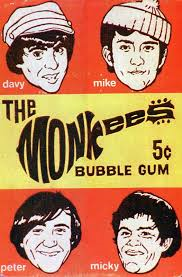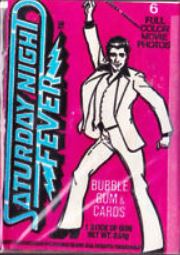
The company’s number one selling product was the “Super Bubble” gum brand. That year, the company name was changed to DONRUSS which was simply a combination of the brother’s first names Donald and Russell Wiener. (Who changed their last name from Weiner to Wiener.)
History of Donruss Trading Cards, Company and Brand – The 1960s -’70s
The company issued its first trading card product in 1961 and was called Idiot Cards. These quirky cards weren’t very successful and the brothers realized that if they were going to be a player in the trading card market, they would have to come up with other ideas. They wisely turned to American pop culture properties.
As a result, during the 1960’s the company produced several licensed trading card products, including
- The Addams Family in 1964
- Disneyland in 1965
- Marvel Super Heroes in 1966
- The Monkees in 1966
- The Monkees (In Color) in 1967
In 1969 the Donruss Company would begin a long and winding road of ownership change, the likes of which the hobby has never seen, when it was purchased by General Mills. Things operated with business as usual despite the acquisition, with the company producing several other non-sport trading card sets in the 1970’s. A few of the more notable properties include:
- The Bionic Woman in 1976
- Saturday Night Fever, Elvis Presley and KISS in 1978
- CHIPS in 1979
History of Donruss Trading Cards, Company and Brand – The 1980s
Things rolled right along for Donruss with the release of the Dukes of Hazard in 1980 and Dallas in 1981.
And then, EVERYTHING, changed in the trading card business . . . . forever.

Although it took several years to resolve, the courts found in Fleer’s favor. Donruss immediately began production of their first baseball card set for release in 1981 with bubble gum.
The short turn-around schedule resulted in several printing errors and variations but the iconic logo we know today, which was originally used a few years prior, was now on baseball cards. The 1981 Donruss Baseball Card Set featured 605 cards and 30 variations due to printing errors. The only key rookie card is that of Tim Raines.
Topps filed an appeal and initially won until a loophole was found by Fleer lawyers allowing the company to, in fact, produce baseball cards as long as they were not packaged with bubble gum.
The 1982 Donruss Baseball Card Set saw the debut of one of the hobby’s most iconic insert sets in the form of Diamond Kings. These art renderings introduced the legendary art of Dick Perez to baseball card collectors. He was also responsible for the creation of the Babe Ruth puzzle, pieces of which were randomly inserted into packs, replacing the bubble gum.
In 1983, General Mills sold Donruss to a conglomerate from Finland which had also recently bought Leaf Confectionery, Inc. of Chicago and Beatrice US Confections. The three operations were combined under the Leaf, Inc. banner but with the Donruss division continuing to have autonomy of its facility to produce baseball and non-sport trading cards.
In 1984, the now famous moniker “Rated Rookie” was first used and the following year the iconic logo made its debut. The company continued to produce baseball cards throughout the late 1980’s and early 90’s. Unfortunately, over-production became an issue and the company was forced to revisit its production and distribution strategies.
History of Donruss Trading Cards, Company and Brand – The 1990s

Donruss rolled out hockey cards for the 1993-94 NHL season and a licensed NFL trading card game in 1995. However, the work stoppages in both baseball and hockey proved devastating. Donruss saw its revenue drop year-over year from 1993 to 1994 from $100M to $50M.
The consequences were too steep for Huhtamaki and they sold Donruss to Pinnacle Brands which included Score. Pinnacle invested heavily into its three major sport licenses in 1997. They took the very popular Elite Series and released it as a stand-alone brand in baseball, football and hockey.
Donruss Preferred was another premium product that attempted to make even the packaging collectible. Housed in a metal tin, each sport had multiple players to collect.
However, the real masterpiece of the Donruss brand under Pinnacle’s ownership was the creation of one of the first-ever super premium products. This came in the form of Donruss Signature Series which GUARANTEED one autographed card in every pack.
All three products proved very successful. However, the investment in new packaging technology, league licensing fees and player autograph contracts left the company cash poor. By July of 1998, sales alone weren’t enough to save Pinnacle and the company filed for bankruptcy.
That same year, Grand Prairie, Texas based Playoff Corporation acquired Pinnancle Brands and with it the Donruss, Score and Leaf brand names as well.
History of Donruss Trading Cards, Company and Brand – 2000 – Present
In 2001 the company name was changed to Donruss Playoff LP. Over the next couple of years, the Donruss name was used in conjunction with new brands including Donruss Classics, Donruss Diamond Kings and the first ever Spanish language product Super Estrelles.
The company garnered international media attention, in 2003, when the company purchased a Babe Ruth game-worn jersey through Leland’s auction house for in excess of $264,000. It was immediately announced that the jersey would be cut up and used in multiple baseball card products in the coming years.
In 2004, Donruss Playoff acquired Pacific Trading Cards further consolidating the trading card market and securing rights to all of Pacific’s brand names.
Licensing contraction by MLB and its players association, in 2006, left Donruss Playoff out of the picture for the time being. Not to give up without a fight, the creative talent at the company would create some innovative ways to circumvent the company’s existing circumstances.
Donruss Playoff would rally and produce cards of MLB players no longer under contract in the form of premium releases, in particular Prime Cuts which proved very successful despite its lack of official licensing.

Over the next few years the company would use the Donruss brand name sparingly. One of the company’s most successful uses of the brand is in their prospect oriented baseball product Donruss Elite Extra Edition.
Then in 2014, to great fanfare and the rejoicing of collectors everywhere, Panini announced the triumphant return of Donruss Baseball.
Following the successful release of Donruss baseball for two years, Panini announces the debut of Donruss Football for the 2015 NFL season. GTS Distribution is named the exclusive distributor for the hobby version of the product.
The Donruss brand is in the hands of skilled management and creative product developers, as the brand continues to evolve, its fun to wonder how this iconic entity of Americana and pop culture will be used in future trading card products.
- 2024 Press Pass Premium Football Cards - April 23, 2024
- 2024 Upper Deck Fleer Retro Looney Tunes Trading Cards - April 23, 2024
- 2023 Panini Chronicles WWE Trading Cards - April 23, 2024



















